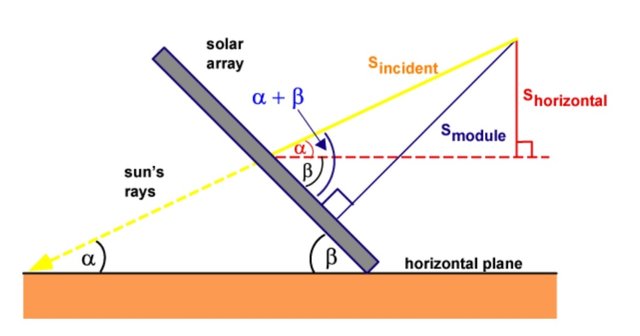The force episode on a PV module depends not just on the force contained in the daylight, yet additionally on the point between the module and the sun. At the point when the engrossing surface and the daylight are opposite to one another, the force thickness on a superficial level is equivalent to that of the daylight (as such, the force thickness will consistently be at its most extreme when the PV module is opposite to the sun). Nonetheless, as the point between the sun and a fixed surface is ceaselessly changing, the force thickness on a fixed PV module is not exactly that of the occurrence daylight.
The measure of sun powered radiation episode on a shifted module surface is the part of the occurrence sun oriented radiation which is opposite to the module surface. The accompanying figure tells the best way to ascertain the radiation episode on a shifted surface (Smodule) given either the sun based radiation estimated on even surface (Shoriz) or the sunlight based radiation estimated opposite to the sun (Sincident).
Shifting the module to the approaching light decreases the module yield.
The conditions relating Smodule, Shoriz and Sincident are:
where
α is the rise point; and
β is the slant point of the module estimated from the level.
The rise point has been recently given as:
where is the scope; and
is the declination point recently given as:
where d is the day of the year. Note that from straightforward math (284+d) is identical to (d-81) which was utilized previously. Two conditions are utilized conversely in writing.
From these conditions a connection among Smodule and Shoriz can be resolved as:
The accompanying dynamic conditions show the computation of the episode and level sunlight based radiation and that on the module. Enter just one of Smodule, Shoriz and Sincident and the program will ascertain the others.
Parts of Radiation on Tilted Surface Calculator

Exhibit Tilt, β =
45
degrees.
Scope, φ =
30
degrees.
Side of the equator: North South
Day Number, d =
30
Declination, δ=
degrees
Sun Angle, α =
degrees.
Shoriz =
30
Sincident =
30
Smodule =
30
Smodule =
Sincident =
Shoriz =
Smodule =
Shoriz =
Sincident =
The slant point significantly affects the sunlight based radiation occurrence on a surface. For a fixed slant point, the most extreme control throughout a year is gotten when the slant point is equivalent to the scope of the area. Notwithstanding, more extreme slant points are advanced for enormous winter loads, while lower title points utilize a more noteworthy part of light in the mid year. The recreation underneath computes the greatest number of sun powered insolation as a component of scope and module point.
Scope: 0°
- 90
90
Cluster Tilt: 45°
0
90
The impact of scope and module slant on the sun based radiation got over time in W.h.m-2.day-1 without cloud. On the x-hub, day is the quantity of days since January 1. The Module Power is the sun oriented radiation striking a shifted module. The module slant point is estimated from the level. The Incident Power is the sun oriented radiation opposite to the sun's beams and is the thing that would be gotten by a module that consummately tracks the sun. Force on Horizontal is the sun based radiation striking the ground and is the thing that would be gotten for a module lying level on the ground. These qualities ought to be viewed as greatest potential qualities at the specific area as they do exclude the impacts of overcast cover. The module is thought to point toward the south in the northern side of the equator and north in the southern half of the globe. For certain points, the light is episode from the back of the module and in these cases the module power drops to 0.
As can be seen from the above activity, for a module slant of 0°, the Module Power and Power on Horizontal are equivalent since the module is lying level on the ground. At a module slant of 80°, the module is practically vertical. The Module Power is not exactly the Incident Power aside from when the module is opposite to the sun's beams and the qualities are equivalent. The module is orientated to the equator so it points toward the north in the Southern Hemisphere and south in the Northern Hemisphere. As module moves from the Northern to Southern Hemisphere (scope = 0°), the module is gone to look the other way thus the Module Power bend flips. At the point when the light is episode from the back of the module the Module Power drops to nothing . Have a go at setting the scope to your area and afterward changing the module slant to see the impact on the measure of force got consistently.